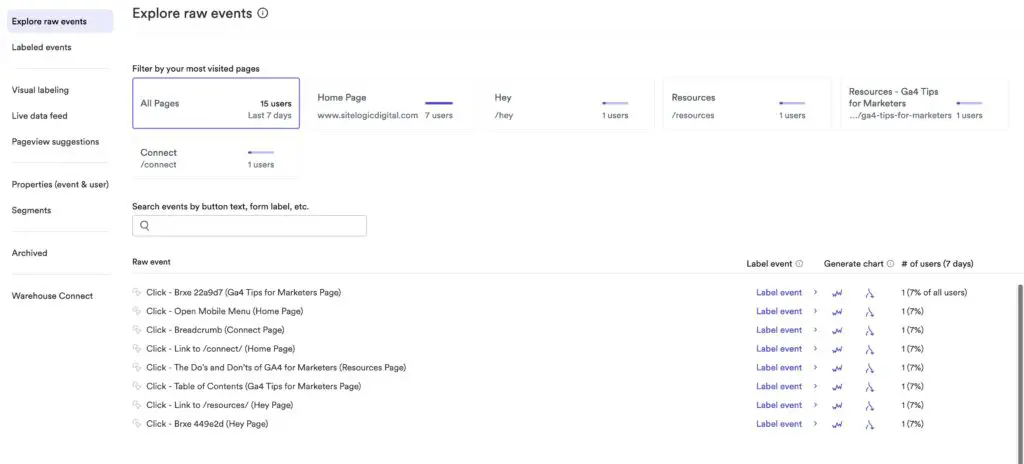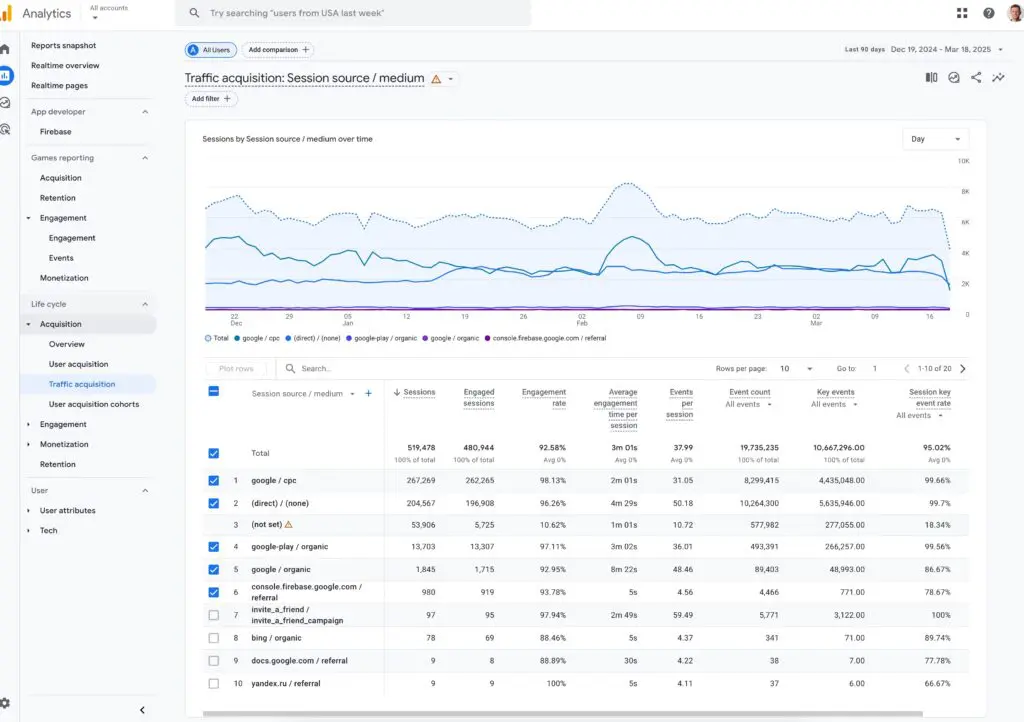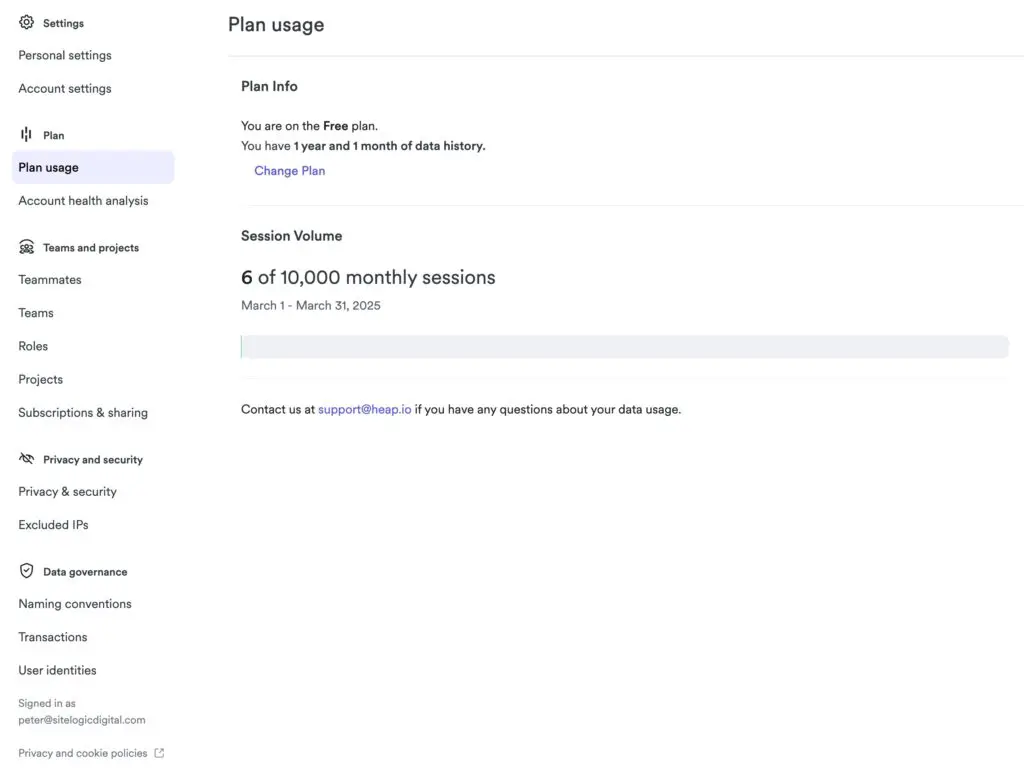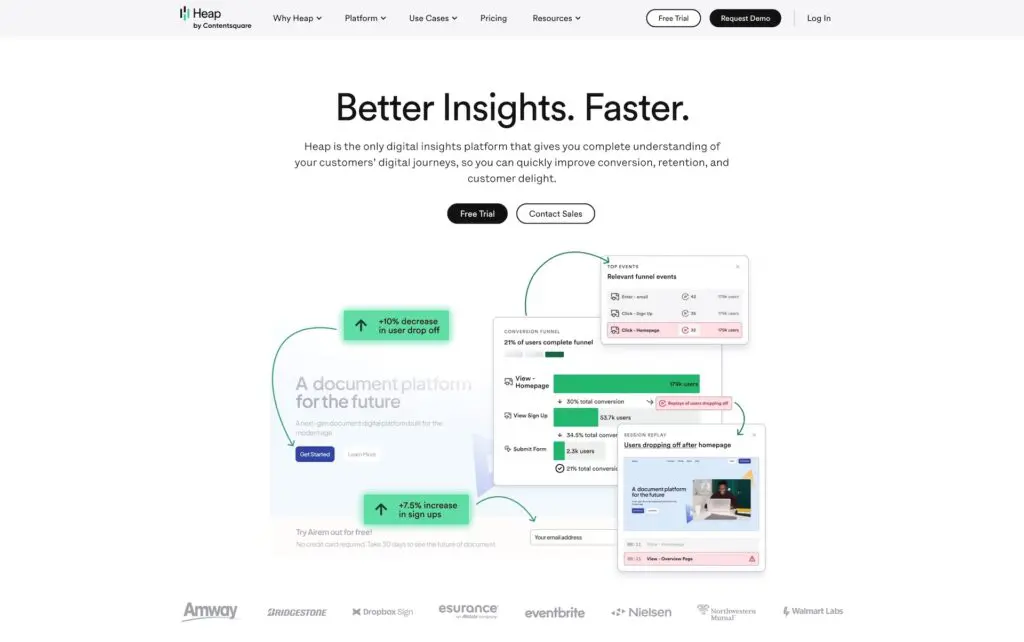Why Choosing the Right Analytics Tool Matters
The right tool can provide invaluable insights into customer journeys, conversion optimization opportunities, and marketing effectiveness. Conversely, choosing an ill-suited platform can lead to missed insights, inefficient workflows, and potentially inaccurate data.
Marketers and product teams need analytics solutions that balance power with usability (which also sometimes means simplicity). This comparison will help you understand the key differences between Heap Analytics and Google Analytics, which each have distinct approaches to data collection and analysis.
What Sets Heap and Google Analytics Apart?
Let’s start by looking at the differences. Heap and Google Analytics are both popular, each with unique features and capabilities that cater to different needs.
- Data Collection Methodology: Heap and Google Analytics differ in how they capture data. Heap automatically tracks all user interactions, providing a comprehensive view of user behavior without manual event tracking. Google Analytics does offer some level of automatic event tracking, but becomes more powerful with customization.
- Data Analysis and Reporting: Heap’s strength lies in its retroactive analysis capabilities. It allows for analyzing historical data without predefined events, providing insights into user behavior patterns and trends over time. Google Analytics 4 includes real-time reporting and predefined event tracking, making it suitable for monitoring current and semi-recent website performance.
- Implementation and Setup: Heap’s implementation is generally considered easier due to its automatic event tracking. Google Analytics requires more technical expertise to set up a lot of event tracking and customize data collection.
- Pricing: Heap offers a free version with limited features and paid plans for advanced functionalities. Google Analytics has a free version that caters to most basic needs and a paid version (Google Analytics 360) for enterprise-level analytics.
Heap vs Google Analytics: what are they?
What is Heap?
Heap is a digital analytics platform that provides automatic event tracking and user behavior analysis. This means that it captures data on every user interaction with a website or application, without requiring manual tagging or coding. This allows businesses to gain insights into how users are interacting with their digital products, and to make data-driven decisions about how to improve the user experience. Heap’s key features include:
- Automatic Event Tracking: Heap automatically captures data on every user interaction, including clicks, page views, form submissions, and more.
- User Behavior Analysis: Heap provides detailed insights into user behavior, including how users navigate through a website or application, where they drop off, and what actions they take.
- Retroactive Analysis: Heap stores all event data, allowing businesses to analyze user behavior retroactively, even for events that were not tracked manually.
- Funnel Analysis: Heap allows businesses to create funnels to track user progress through key conversion paths and identify areas for improvement.
- User Segmentation: Heap allows businesses to segment users based on their behavior and attributes, and to tailor the user experience accordingly.
Heap’s Key Features and Capabilities
Heap offers a robust set of features designed to help businesses understand and optimize their digital experiences:
- Virtual Events: Define and analyze specific user actions without additional code deployment
- Effort Analysis: Measure how much effort users expend to complete certain tasks
- Path Analysis: Discover the most common user journeys through your site
- Session Replay: Watch recordings of user sessions to understand real behaviors
- Advanced Segmentation: Create complex user segments based on multiple behaviors and attributes
- Conversion Insights: Automatically identify factors that influence conversion rates
- Autocapture Technology: Collect data on all user interactions without manual configuration
- User Identity Resolution: Connect user behaviors across devices and sessions

What is Google Analytics?
Google Analytics is generally viewed as a “default” analytics tool. It allows website owners to measure and analyze various aspects of user engagement, such as the number of visitors, page views, session duration, bounce rate, traffic sources, and user demographics.
- Data Collection: Google Analytics collects data through a JavaScript tracking code that is embedded on website pages. This code tracks user interactions and sends information to Google’s servers.
- Reporting and Analysis: The collected data is processed and presented in various reports and dashboards within the Google Analytics interface. These reports provide insights into website traffic patterns, user behavior, and conversion rates.
- Key Events and Conversions: Google Analytics allows users to set up key events and track conversion-related activities, such as purchases, form submissions, or newsletter signups. This helps measure the effectiveness of marketing campaigns and website content.
- Audience Segmentation: Users can segment their audience based on various criteria, such as demographics, interests, and behavior. This allows for targeted marketing and personalized content delivery.
- Integration: Google Analytics integrates with other Google products, such as Google Ads and Google Search Console, providing a comprehensive view of website performance and marketing efforts.
Google Analytics’ Key Features and Capabilities
Google Analytics, particularly with the GA4 implementation, offers a comprehensive set of features:
- Event-Based Tracking: Measure specific user interactions like clicks, scrolls, and form submissions
- Acquisition Reports: Understand where your traffic is coming from
- Behavior Flow: Visualize how users navigate through your site
- Conversion Tracking: Monitor important business goals and calculate ROI
- Custom Dimensions and Metrics: Create personalized data points specific to your business
- Advanced Filtering: Refine data views to focus on specific segments
- Predictive Analytics: Leverage machine learning to forecast user behavior
- E-commerce Tracking: Monitor product performance, sales, and shopping behavior
- Cross-Platform Tracking: Follow users across devices and platforms
- Anomaly Detection: Automatically identify unusual patterns in your data
Advantages and Disadvantages of Heap Analytics
The Advantages of Heap
- Automatic Event Tracking: Heap automatically captures user interactions, eliminating the need for manual code implementation for every event. This saves time and effort, especially for non-technical users.
- Retroactive Analysis: Heap’s ability to track data retroactively means you can analyze past user behavior even if you didn’t set up tracking for specific events in advance. This allows for valuable insights and flexibility in your analysis.
- User-Centric Focus: Heap prioritizes understanding individual user journeys, providing detailed insights into how users interact with your product or website. This can help you personalize experiences and optimize for conversions.
- Minimal Technical Setup: Implementation requires minimal developer resources, making it accessible for teams with limited technical support.
- Intuitive Interface: Heap’s user interface is designed to be approachable for non-technical users while still offering powerful analytical capabilities.
The Disadvantages of Heap
- Cost: Heap can be expensive, especially for businesses with high traffic volumes or complex data requirements. The pricing structure may not be suitable for all budgets.
- Data Sampling: Heap may use data sampling for large datasets, which can affect the accuracy and representativeness of your analysis. This is important to consider if you require precise data for critical business decisions.
- Learning Curve: While Heap offers a user-friendly interface, there is still a learning curve involved in mastering its features and capabilities. Users may need to invest time in training and onboarding to fully leverage the platform.
- Limited Customization: Compared to some other analytics tools, Heap may have limitations in terms of customization and flexibility. This can be a drawback for businesses with unique tracking requirements or complex data structures.
- Data Management: The automatic tracking can lead to data overload, requiring careful management and organization of the information collected.
Strengths and Weaknesses of Google Analytics
The Advantages of Google Analytics
- Comprehensive Ecosystem: Google Analytics integrates seamlessly with other Google products like Google Ads, Search Console, and Looker Studio, creating a powerful ecosystem for digital marketing analysis.
- Cost-Effective: The standard version of Google Analytics is free, making it accessible for businesses of all sizes. Even the paid version (GA360) is competitively priced compared to enterprise analytics solutions.
- Robust Reporting: Google Analytics offers a wide range of pre-built reports and dashboards that provide immediate insights into website performance, user behavior, and conversion metrics.
- Community Support: As one of the most widely used analytics platforms, Google Analytics benefits from extensive community support, including tutorials, forums, and third-party resources.
- Continuous Evolution: Google regularly updates and improves Analytics, ensuring it keeps pace with changing digital marketing needs and technology advancements.
The Disadvantages of Google Analytics
- Learning Curve: The platform’s comprehensive nature means there’s a significant learning curve, especially for GA4, which introduced many changes from Universal Analytics.
- Complex Setup for Advanced Tracking: Implementing custom event tracking and enhanced e-commerce features can be technically challenging, often requiring developer resources.
- Limited Retroactive Analysis: Unlike Heap, Google Analytics cannot analyze data retroactively for events that weren’t explicitly tracked when they occurred.
- Data Sampling Issues: For websites with high traffic volumes, Google Analytics may sample data, potentially affecting the accuracy of reports.
- Privacy Concerns: Some users have concerns about Google’s data collection practices, which can be problematic for businesses operating in regions with strict privacy regulations.

Who Should Use Heap vs. Google Analytics?
Heap is Ideal for:
- Product Teams: Those focused on understanding user experience and product usage patterns will benefit from Heap’s automatic event tracking and user-centric analysis.
- Organizations with Limited Technical Resources: Companies without dedicated developers for analytics implementation will appreciate Heap’s automatic data collection.
- Businesses Prioritizing User Journey Analysis: Organizations focused on understanding and optimizing the customer journey will find value in Heap’s retroactive analysis capabilities.
- Startups and Agile Teams: Teams that need quick insights and the ability to analyze data without planning all tracking in advance will benefit from Heap’s flexibility.
- Companies with Budget for Analytics: Organizations willing to invest in a premium analytics solution for deeper insights and less technical overhead.
Google Analytics is Ideal for:
- Marketing Teams: Those focused on campaign performance, traffic sources, and audience demographics will find Google Analytics’ marketing-centric approach valuable.
- SEO Specialists: Professionals who need to track organic search performance and integrate with Search Console will benefit from Google Analytics’ integration capabilities.
- Budget-Conscious Organizations: Companies looking for a cost-effective analytics solution with robust capabilities will appreciate Google Analytics’ free tier.
- Businesses within the Google Ecosystem: Organizations already using Google Ads, Search Console, or other Google products will benefit from the seamless integration.
- Companies with Technical Resources: Organizations with development teams capable of implementing custom tracking and maintaining the analytics setup will be able to leverage Google Analytics’ full potential.
Data Collection: Automatic vs. Manual Tracking
How Heap Captures Data Automatically
Heap’s automatic data collection works through a process called “autocapture,” which records all user interactions with your website or application without requiring manual setup for each event. Here’s how it works:
- Initial Implementation: A single JavaScript snippet is added to your website or application code.
- Comprehensive Tracking: Once installed, Heap automatically tracks all user interactions including clicks, form submissions, page views, and field changes.
- DOM Element Tracking: Heap identifies and tracks elements based on their attributes, classes, and structure within the Document Object Model (DOM).
- Virtual Events: After data is collected, you can define “virtual events” in the Heap interface to organize and analyze specific user actions without additional code deployment.
- Historical Data Analysis: Since all interactions are tracked from the moment of implementation, you can analyze any past user behavior, even for events you didn’t specifically define when they occurred.
This approach means that business users can define and analyze events without requiring developer assistance each time, significantly reducing the technical overhead of maintaining an analytics implementation.
How Google Analytics Uses Manual Event Tracking
Google Analytics employs a more traditional approach to event tracking that requires explicit configuration for each interaction you want to monitor:
- Base Implementation: The Google Analytics tracking code is added to your website or application.
- Default Tracking: By default, GA tracks page views and some basic user information like location and device type. Enhanced measurement events do offer limited codeless event tracking for things like form interactions, scrolls, and file downloads.
- Custom Event Configuration: To track specific user interactions (like button clicks or form submissions), you must manually implement event tracking code for each action.
- Event Structure: Events in Google Analytics are defined with a specific structure including Category, Action, Label, and Value parameters.
- Data Collection Limits: Once implemented, GA only collects data on the specific events you’ve configured. If you want to track new events, you must add new tracking code.
With GA4, Google has moved closer to an event-based model similar to Heap, but still requires more manual configuration than Heap’s autocapture approach. The implementation typically requires ongoing developer resources to maintain and expand tracking capabilities.
Which Approach is Most Effective for Your Business?
The choice between automatic and manual tracking depends on your business needs, resources, and analytics goals:
Automatic Tracking (Heap) May Be Better If:
- You have limited technical resources for ongoing analytics maintenance
- You want to minimize the risk of missing important user interactions
- Your analysis needs are evolving and you want flexibility to explore data retroactively
- You’re focused on understanding user behavior and product usage patterns
- You prefer a “capture everything” approach that allows for discovery of unexpected insights
Manual Tracking (Google Analytics) May Be Better If:
- You’re primarily focused on marketing performance and campaign attribution
- You have clear, established KPIs and know exactly what you need to track
- You’re concerned about data storage costs or performance impacts
- You have technical resources available for implementation and maintenance
- You want complete control over what data is collected and how it’s structured
Some businesses find that a hybrid approach works best, using Heap for comprehensive user behavior analysis and Google Analytics for marketing performance tracking and campaign attribution.
User Behavior Tracking: Understanding Your Audience
How Heap Tracks User Journeys and Actions
Heap approaches user behavior tracking from a user-centric perspective, focusing on individual journeys and comprehensive interaction data:
- User Identification: Heap assigns unique identifiers to visitors and maintains user profiles that connect behaviors across sessions and devices.
- Complete Interaction Capture: Every click, form fill, page view, and other interactions are recorded automatically.
- Session Replay: Heap offers session replay functionality that allows you to watch anonymized recordings of actual user sessions.
- Funnel Analysis: Heap allows you to create conversion funnels to track user progress through key paths, with the ability to retroactively adjust these funnels.
- Path Analysis: You can discover the most common routes users take through your site or application.
- Effort Analysis: Heap measures how much effort (clicks, time, etc.) users expend to complete tasks.
This approach gives you a holistic view of the user experience, helping you understand not just what users do, but how they navigate your product and where they encounter difficulties.
How Google Analytics Maps User Interactions
While Google moved from session-based tracking to event-based tracking with the introduction of GA4, there is still some level of tracking from an aggregate viewpoint:
- Event Tracking: Specific user actions are tracked as events when manually implemented.
- Behavior Flow: GA provides visualization tools to see how users move through your site, highlighting common paths and drop-off points.
- Session-Based Analysis: GA organizes data into sessions, which are groups of user interactions that take place within a given time frame.
- Key Event Tracking: You can set up Key Events (formerly known as goals) to track specific conversion actions and measure completion rates.
- Enhanced Measurement: GA4 offers enhanced measurement which automatically tracks some common events like scrolls and outbound clicks.
- User Explorer: This feature allows you to examine individual user journeys, though with less detail than Heap provides.
Google Analytics is particularly strong at providing aggregate insights about user behavior and connecting this behavior to acquisition sources and marketing campaigns.
Accuracy and Granularity of Data
The accuracy and granularity of data differ between Heap and Google Analytics.
Heap
- Comprehensive Data: Captures all user interactions, providing maximum granularity
- Minimal Data Loss: Less likely to miss important user actions since everything is tracked
- User-Level Analysis: Stronger capabilities for analyzing individual user journeys and behaviors
- Retroactive Analysis: Can analyze data that wasn’t explicitly tracked when it was collected
- Minimal Sampling: Generally provides more complete data without aggressive sampling
⠀Google Analytics
- Selective Data: Captures only the events and interactions you’ve specifically configured
- Potential Gaps: May miss important user actions if they weren’t explicitly tracked
- Aggregate Analysis: Stronger focus on aggregate metrics and trends rather than individual journeys
- Data Sampling: More likely to sample data, especially for high-traffic sites on the free tier
- Session-Based Focus: Organizes data into sessions rather than comprehensive user profiles
For businesses that need highly detailed user behavior data and the ability to explore interactions retroactively, Heap generally provides more accurate and granular data. However, for businesses primarily focused on marketing performance and aggregate trends, Google Analytics often provides sufficient accuracy while being more cost-effective.
Ease of Use: Which Tool is More User-Friendly?
Implementing Heap
- Quick initial setup due to automatic tracking.
- Minimal technical skills required.
Setting up Google Analytics
- More time-intensive initial setup.
- Requires technical expertise for advanced configurations.
Integrations and Compatibility
Heap Integrations
- Connects seamlessly with platforms like Salesforce, Marketo, and HubSpot.
- Limited compared to GA’s extensive ecosystem.
Google Analytics Integrations
- Rich ecosystem including Google Ads, Search Console, Looker Studio, and more.
- Ideal for marketers using multiple Google services.
Using Both Tools Together
- Combining Heap’s granular user tracking with GA’s broad analytics can offer comprehensive insights.
Pricing Considerations
Heap Analytics Pricing
- Free tier with limitations; premium plans can be costly.
- Suitable for smaller teams or companies needing deep user journey insights.

Google Analytics Pricing
- Free version (GA4) meets most marketing needs.
- Enterprise features available with GA360.
Making Analytics Simple with sitelogic.app
For marketers already using GA who want simplicity without sacrificing insight, tools like Sitelogic.app offer streamlined, marketer-friendly views of your analytics, making it easy to focus on actionable insights and strategic decision-making.
FAQs
How long does implementation take?
- Heap: Usually within hours to days.
- GA: Days to weeks, depending on complexity.
Do I need a developer?
- Heap: Minimal developer involvement.
- GA: Sometimes yes, especially for custom events.
What about GDPR and CCPA compliance?
- Both platforms support GDPR and CCPA, but compliance specifics vary based on setup and usage.
Which tool is better for marketing analytics?
- Heap: Better suited for detailed user-product interactions.
- GA: Stronger for campaign tracking, traffic sources, and website performance analysis.
